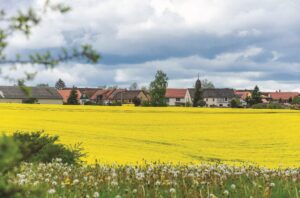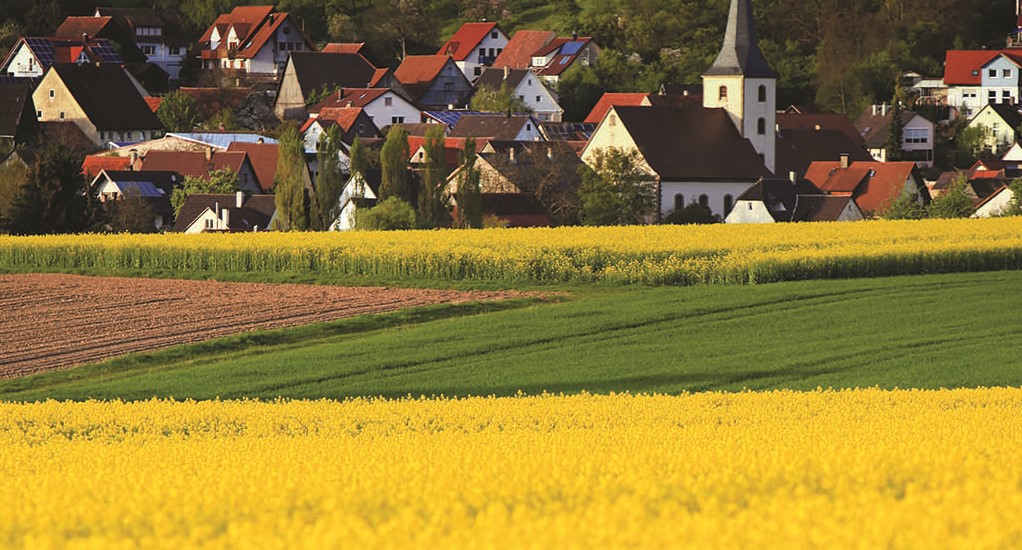What can we learn from Germany?
Canola yields in Europe are the best in the world, and Germany is the best of the best. Europeans call the crop oilseed rape (OSR), which is Brassica napus with low glucosinolates and low erucic acid. It differs from canola in name only. Average OSR yields in Germany for the decade from 2012 to 2021 were 3.6 tonnes per hectare, or 64 bu./ac., according to data from the Food and Agriculture Organization of the United Nations (FAO). Canada’s average over those same years was 2.1 tonnes per hectare, or 37 bu./ac.
Big reasons for high German yields are winter cultivars, high inputs and a long growing season. “Germany’s climate is very conducive to winter rapeseed,” says Bryan Purcell, crop production analyst for Europe for the United States Department of Agriculture’s Foreign Agricultural Service (FAS). “The crop calendar and maritime climate of the country suit it very well, usually protecting it from extremes that can occur further inland.”
German farmers also have a 10- to 11-month growing season, planting in August-September and harvesting the following summer. “We see in Europe significantly higher yield in winter OSR than in spring OSR,” says Mario Schneider, head of agronomic service for BASF in Germany.
“German farmers have years of experience with the crop and have the financial resources to obtain certified seeds, modern equipment and all the permittable inputs. They have well established research institutions and outreach programs to help guide them.”
— Bryan Purcell
Management and inputs
“German farmers have years of experience with the crop and have the financial resources to obtain certified seeds, modern equipment and all the permittable inputs,” Purcell says. “They have well established research institutions and outreach programs to help guide them.”
German farmers also use a lot of inputs. Schneider says winter OSR in Germany is a “high input crop.”
Seed genetics: OSR in Germany is non-GMO, but some cultivars have herbicide tolerance. Seed companies offer Group-2 tolerant Clearfield cultivars. Key genetic traits are resistance to blackleg (called “phoma” in Europe) and turnip yellows virus, which aphids transmit to OSR through feeding. Common seed treatments are the fungicides fluopicolide and fluoxastrobin for seedling diseases. They don’t have neonicotinoid seed treatments, and current replacements are not as effective.
Fertilizer: In Germany, farmers must do field specific fertilizer calculation before the first treatment. “It is mandatory and requested by law,” Schneider says. This calculation is based on field characteristics, including previous crop, history of manure application, and soil quality, carbon content and available nitrogen.
Schneider gives an example: For an OSR yield target of 4.0 tonnes per hectare (71 bu./ac.), medium carbon content, 40kg/ha (about 35 lb./ac.) nitrogen available at the beginning of the growing season, and no history of manure, the nitrogen rate that can be applied is 165kg/ha, or about 150 lb./ac. In addition to nitrogen, most farmers apply 70-80kg/ha of phosphate, 70-80kg/ha of potassium (K2O) and 500-700g/ha of boron.
Disease management: Even with blackleg-resistant cultivars, some farmers will apply fungicide to protect against blackleg infection in the fall or early spring. Schneider notes that in most cases this fungicide application is used more for its growth regulating effect. He says 90 per cent of OSR in Germany gets a growth regulating treatment of fungicide, often metconazole. This shortens the crop to reduce lodging, reduces flower counts on the main stem to improve light infiltration to leaves, and increases rooting. At flowering, farmers will apply another fungicide treatment, or treatments, to protect against sclerotinia stem rot. Again, about 90 per cent of farms apply this treatment, Schneider says. Clubroot is also common in Germany.
Weed management: Without herbicide-tolerant technology, farms manage weeds with tillage, pre-emergent or early post-emergent herbicide, and late-fall applications to remove grassy weeds. By spring, the crop has complete ground cover and weed competition is minimal.
Insect management: Without neonic seed treatments, the alternative seed treatments are much less effective on flea beetles and aphids. Foliar applications are required. The most important insect pest is cabbage stem flea beetle. Adults feed on young canola plants, and their larvae hatch and feed inside stems. Other important insect pests in Germany are pollen beetle, aphids, rape stem weevil and cabbage seedpod weevil.
Simon Kröger, oil crops product management lead with seed company DSV in Germany, says early season vigour is essential to insect management without effective seed treatments. “To have ideal conditions for emergence and early vigour, precision drilling is used more widely with maize and sugar beet drills,” Kröger says. He adds that farmers and researchers are also experimenting with companion crops to mask the OSR and make it less attractive to beetles. Starter fertilizer helps with vigour. And farmers spray pyrethroids in autumn, “but with limited success,” he says.
Schneider adds that German farmers are increasing the break between OSR crops.
“My personal opinion is that we would be able to extract 0.5-1.0 t/ha more [with] no limit with fertilization and full availability of modern insecticides.”
— Mario Schneider
Major yield-limiting factors
Schneider says insect pressure and dry weather in April and May are the most limiting factors for higher yield. Germany’s lowest average yield for the past decade was 2.99 t/ha (53 bu./ac.) in 2018, and the major factor, Schneider says, was a long, very dry period in spring and early summer in an important production region.
Purcell provides a longer list of weather challenges: too much rain during flowering, late freeze during April and early May, dryness at planting, dryness at flowering and podfill, flooding after emergence, and high temperatures during flowering. To this last one, he adds that because flowering is fairly early in the year (April-May), excess heat at flowering is not usually a problem. “Farmers are all complaining about climate change producing more extreme events and more challenges,” Purcell says.
Another major yield-limiting factor is government policy.
“Due to the neonic ban, cabbage stem flea beetle is very prevalent and has gotten worse,” says Purcell. The EU ban took effect after the 2018 production year. Purcell says OSR seeded area and yields shrunk after the ban, and have started to show a gradual rebound.

Purcell also highlights the restrictions on nitrogen and phosphorus use. Farms have to document the quantities of nitrogen and phosphorus, and if they don’t follow the formula rates, as Schneider described in the earlier example, farms can be fined up to 50,000 Euros.
Purcell adds that for some “nitrate vulnerable zones,” where nitrogen pollution is already at a very high level, the maximum permitted amount of nitrogen is 20 percent lower than the calculated requirement.
As good as Germany’s OSR yields are, Schneider says they could be better. “My personal opinion is that we would be able to extract 0.5-1.0 t/ha more [with] no limit with fertilization and full availability of modern insecticides,” he says.
Purcell says German farmers feel like the public is turning against them. “They are very concerned about what they perceive as an increasing negative view of the farmer by the public and the pressures that the public puts on politicians to increase bans on farming activities,” Purcell says.
Do you think any of the practices common in Germany should be considered in Canada? Please email the author and share your thoughts.
Clint’s callouts
Canola Digest asked Clint Jurke, the Canola Council of Canada’s agronomy director, to highlight two German practices he’d like Canada to consider. Here are his picks:
- Germany shows us what yield potential is possible. We can improve yields here in Canada with better fertility plans.
- Another thing we can learn is what happens with bad regulation. Limits on crop inputs will reduce yield. And the public opinion about German farmers is our future if we cannot engage the public effectively.





